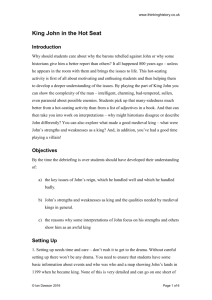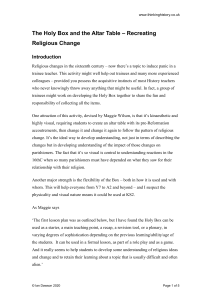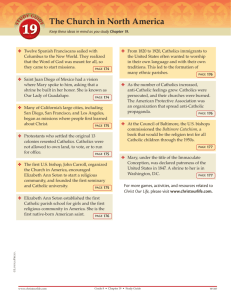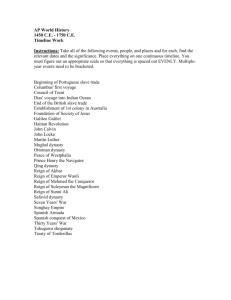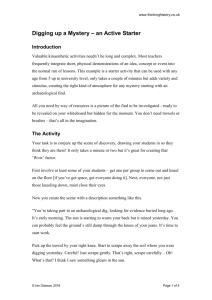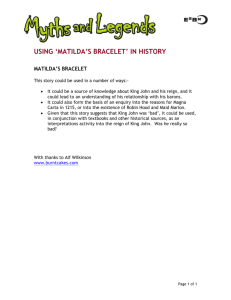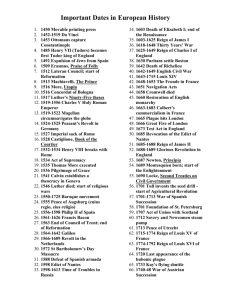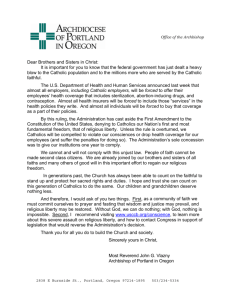How do you feel about the country's new religion?
advertisement
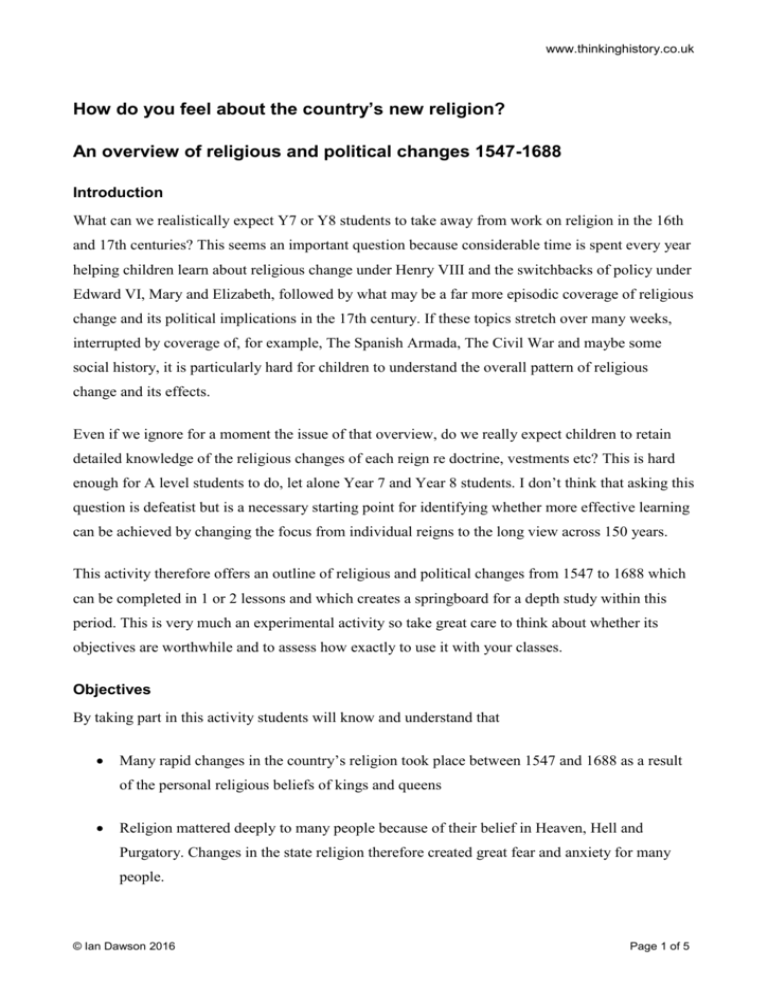
www.thinkinghistory.co.uk How do you feel about the country’s new religion? An overview of religious and political changes 1547-1688 Introduction What can we realistically expect Y7 or Y8 students to take away from work on religion in the 16th and 17th centuries? This seems an important question because considerable time is spent every year helping children learn about religious change under Henry VIII and the switchbacks of policy under Edward VI, Mary and Elizabeth, followed by what may be a far more episodic coverage of religious change and its political implications in the 17th century. If these topics stretch over many weeks, interrupted by coverage of, for example, The Spanish Armada, The Civil War and maybe some social history, it is particularly hard for children to understand the overall pattern of religious change and its effects. Even if we ignore for a moment the issue of that overview, do we really expect children to retain detailed knowledge of the religious changes of each reign re doctrine, vestments etc? This is hard enough for A level students to do, let alone Year 7 and Year 8 students. I don’t think that asking this question is defeatist but is a necessary starting point for identifying whether more effective learning can be achieved by changing the focus from individual reigns to the long view across 150 years. This activity therefore offers an outline of religious and political changes from 1547 to 1688 which can be completed in 1 or 2 lessons and which creates a springboard for a depth study within this period. This is very much an experimental activity so take great care to think about whether its objectives are worthwhile and to assess how exactly to use it with your classes. Objectives By taking part in this activity students will know and understand that Many rapid changes in the country’s religion took place between 1547 and 1688 as a result of the personal religious beliefs of kings and queens Religion mattered deeply to many people because of their belief in Heaven, Hell and Purgatory. Changes in the state religion therefore created great fear and anxiety for many people. © Ian Dawson 2016 Page 1 of 5 www.thinkinghistory.co.uk People’s attitudes to religion and to government were strongly linked. The main reason for opposing a monarch and his or her government was almost always because of religious differences. Resources PowerPoint sequence – reign by reign summary of changes A4 graph for completion Role card reminders for the religious groups The Activity This assumes you have already covered religious changes under Henry VIII. 1. Split your class into 3 groups –in a class of 30 you would have roughly 5 Puritans, 15 moderates and 10 Catholics. Have them grouped or spread across room with Puritans on one side and Catholics on the other, the moderates in the middle. [The proportions of these groups would obviously have changed across this lengthy period but that’s a complexity that would interfere with establishing the basic pattern from this activity.] 2. Identify what kind of religion each group of people wants. Some of this at least should be recalled from work on Henry VIII and it’s a good chance for consolidation. what do Catholics want? [e.g. colourful churches, statues and images, services in Latin, leadership by the Pope and priests] what do Puritans want? [no distractions between the people and God i.e. no colour, ornaments, colourful clothing. They want simple services in English, no Pope or bishops.] what do the moderates in the middle want? [a religion that’s familiar and comforting, no foreign control (Spain, the Pope), the chance to have fun away from church.] Make sure each group is clear on what they want. Give them the role-card reminders. © Ian Dawson 2016 Page 2 of 5 www.thinkinghistory.co.uk 3. Ask class - what do you all fear? – provide a reminder of the dangers of Purgatory and Hell for those who have not followed the true religion. You could use the activity ‘How can you spend less time in Purgatory?’ before starting this one: http://www.thinkinghistory.co.uk/ActivityBase/SpendLessTimeInPurgatory.html 4. Give out or ask students to draw the outline of a living graph of happiness/fear depending on the religion and politics of country. [See example] Their task is to complete the graph from the perspective of their group. Students may work best in pairs, sharing the thinking and graph-completion. 5. Use the PowerPoint screens to complete the graph. Take each reign from Edward VI to William and Mary in turn, asking students in role to think about how they feel about the religious changes taking place. Are they happy with the country’s religion or do they feel afraid? The information provided is deliberately brief. The aim is to use the details to develop a sense of the pattern of religious change and its political implications - not for students to remember the details although that would be a happy by-product! For each reign use the information to help each group of students think about their reactions – with some classes it may help to encourage a sense of triumphalism or relief when the state religion swings one way or the other. This may help students realise that there was a real depth of feelings involved and that this wasn’t an academic exercise for people at the time – and this in turn will help them appreciate why some took extreme actions. The extent of class discussion will vary according to the nature of the class and how long you want to devote to this activity. Students should complete the graph for each reign before you move onto the next reign. You might also ask them to annotate their graph or make brief notes to explain their positioning on the graph for each reign. Some individual questions or prompts you might use in discussion are: Edward VI – this is far more Protestant religion than the reforms of Henry VIII – who will be pleased? © Ian Dawson 2016 Page 3 of 5 www.thinkinghistory.co.uk Mary – why did some people refuse to accept this return to Catholicism? Which group in the classroom were the martyrs likely to come from? Elizabeth – why were both Catholics and Puritans unhappy? Why do you think Catholics did not support the Armada? James I – why were most people relieved by James’s religion? Which event made many people very suspicious of Catholics? Which event in Elizabeth’s reign was the Gunpowder Plot a reminder of? Charles I – why were the Puritans especially unhappy? Why were Puritans likely to fight against Charles when the Civil War began? The Commonwealth – why did some Catholics emigrate to America? Were Catholics the only ones unhappy with this government? Charles II – which group was most unhappy at the religious changes? James II – why were many people afraid that he would make the country’s religion Catholic? What does this reign tell you about how afraid people were of Catholics? William and Mary – who was least happy about the country’s religion? 6. How would you describe 1688? The final slide looks at the name ‘Glorious Revolution’ – a great example of History being written by the winners! Begin by asking the groups how they feel now that William and Mary have replaced James – do they feel relieved, triumphant, despairing etc. Now ask them to suggest a title for the events of 1688 – ‘The ……. Revolution’ . What word would they suggest to fill the gap? The screen offers some possibilities. Finally reveal that this event is usually known as ‘The Glorious Revolution’ – who do they think gave it that name and why? Does everyone in the class agree? © Ian Dawson 2016 Page 4 of 5 www.thinkinghistory.co.uk Debriefing There are a number of issues you could discuss depending on your choice of focus and how much time you have. It’s up to you to select what will work best with each class. what do your graphs look like –what were your best and worst moments? what could you do if you hated government decisions? (rebel? Join a plot? go to America?) how does this explain why Catholics were not allowed to vote until 1829? [and why Britain had a German king in 1714 and why the monarch was not allowed to be or to marry a Catholic] And the most important and difficult question: What have you learned from this activity? - try to help students towards the understandings listed in Objectives above. Reflections This activity needs careful evaluation after use – all activities do but the unusual nature of this kind of overview means it particularly merits careful evaluation. You might like to consider the following questions: Did the activity engage and interest students and were they able to complete the graph effectively? Did students gain an understanding of the overview of the patterns of change and continuity and see the purpose of the activity? Do you feel that this kind of overview activity helps with the organization of your KS3 scheme of work – if so, are there any other topics where this approach could be used? Will you build on this through a depth study on religious change in this period – which period/topic and what will the enquiry question be? If you use this activity again, how will you do it better? © Ian Dawson 2016 Page 5 of 5
